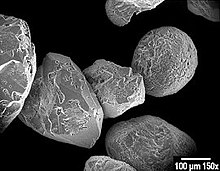Quartz sand

Quartz sand is a type of sand that consists predominantly of quartz grains . In general terms and in a technical context, however, it is usually used to describe sands that consist almost exclusively of quartz grains.
use
Manufacturing industry
Largely pure quartz sands are mainly used in the glass industry for the production of flat glass (float) and hollow glass . Only sands that are low in iron (less than 0.03% by weight Fe 2 O 3 ) are suitable for the production of white glass. Fine sands with a grain size of 0.1 to 0.5 mm and a residual moisture content of less than 5% water (so-called wet sand) are predominantly used in the melting furnaces , as small grain sizes enable a more homogeneous mixture, especially with regard to coloring additives Water lowers the melting point.
Pure quartz sand is also used in the manufacture of ceramics , in enamelling , in glass fibers , in the chemical industry, in grinding and cleaning agents, in foundries as a material for the sand molding process , as a lean agent , as a filler (e.g. in quartz sand gloves ) as well as blasting sand , brake sand or in horticulture as a soil improver ("lawn quartz").
Frac sand
Medium to coarse-grained, pure quartz sand grain with a high degree of roundness is used as a support means ( English proppant ) for the oil and gas production by means of fracturing required. For this frac sand , the so-called Ottawa Silica Sand or Northern White applies in the USA , which is made of weakly consolidated sandstones and the like. a. the Cambodian-Ordovician Jordan Formation and the Ordovician St. Peter Formation in Minnesota , Wisconsin and Illinois is obtained as the standard. Less significant occurrences are formed by stratigraphic equivalents of these formations in Oklahoma , Arkansas , Texas and Missouri . The drastic increase in unconventional oil and natural gas production in the USA since 2000 has led to an increase in demand and thus to an expansion of the mining of such sands, especially in the states of Wisconsin and Minnesota.
Production rates and other occurrences
The world's quartz sand reserves are stated to be practically unlimited. There are very large deposits in large parts of Europe. World production in 2013 was 142 million tons.
According to the Federal Association of Mineral Raw Materials (MIRO), the annual production of (pure) quartz sand in Germany in 2014 was 10.4 million tons. Almost 2 million tonnes of this were exported, with more than three quarters (77%) of the export going to the Benelux countries. The quartz sand is predominantly extracted from geologically relatively young or very young loose sediments , among others in Uhry (southern Lower Saxony) or in Haltern am See (Münsterland). However Partly it falls as a by-product of the mining and processing of kaolin containing sandstone at, for example in the Middle Bunter Sandstone of the Upper Palatinate (see → Monte Kaolino ). One of the most important quartz sand mining companies in Germany is the Quarzwerke Group , headquartered in Frechen .
In Austria, quartz sand is obtained mainly from Tertiary deposits on the southern edge of the Bohemian Massif. These deposits are known under the names Linzer Sande and Melker Sande . The average annual output of quartz sand in Austria is around 1 million tons.
literature
- Winfried Koensler: Sand and gravel - mineralogy, occurrence, properties, possible uses. Enke Verlag, Stuttgart 1989, ISBN 978-3-432-97551-1
Web links
Individual evidence
- ^ Mary Ellen Benson, Anna B. Wilson: Frac Sand in the United States - A Geological and Industry Overview. USGS Open File Report 2015–1107. United States Geological Survey, Department of the Interior, Washington, DC 2015, doi : 10.3133 / ofr20151107
- ↑ Thomas P. Dolley: Silica. USGS 2013 Minerals Yearbook. United States Geological Survey, Department of the Interior, Washington, DC 2015 ( PDF )
- ↑ Dieter Huy, Harald Andruleit, Hans-Georg Babies, Harald Elsner, Doris Homberg-Heumann, Jürgen Meßner, Simone Röhling, Michael Schauer, Sandro Schmidt, Martin Schmitz, Michael Szurlies, Bernard Wehenpohl: Germany - raw materials situation 2014. Federal Institute for Geosciences and Raw materials, Hannover 2015, ISBN 978-3-943566-29-1 , p. 46 ( online )
- ↑ Quartz sand. ( Memento from January 5, 2016 in the Internet Archive ) Internet presence of the then Austrian Federal Ministry for Science, Research and Economy


